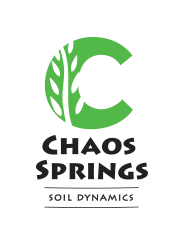Creating On-Farm Fertility
/At Chaos Springs we have developed a system over our 40 years of organic growers to create fertility largely from within the farm boundary. This works by following these six practices.
• Correct Seed Selection
• Precise Composting Methods
• Farm Specific Plant Extracts
• Appropriate Crop Rotations
• Accurate Grazing Management
• Energetic Systems – Quantum Base Agriculture
A quick look at these ideas are detailed in our soon to be released e-book Creating on Farm Fertility. Check the website for the release date and subscribe to the newsletter to stay up to date.
Here are the basics:
Correct Seed Selection: The seed is the beginning of the cycle of life in the soil. Seeds are known to contain millions of micro-organisms that explode into the soil when the seed germinates. These microbes then develop a relationship with the surrounding soil and as the photosynthesis process begins to convert sunlight into sugars and a very complex network of exchange begins. Each seed is unique in the microbe make up that it contains selecting the correct seed for the plant you want is obvious, but selecting the seeds to compliment that seed and plant is a more complex process. Getting to know your seeds is key.
Precise Composting Methods: Composting has been part of agriculture for around 5000 years. Almost every culture has practices some sort of recycling of nutrients back to the soil. (except for what is known as conventional agriculture during the last century, they seem to have forgotten this). There are many methods of composting available and most eventually produce good results. But you can enhance this by paying attention to a few basic parameters, the most important being moisture management. You can find out more about precise composting methods as well as compost teas and extracts by emailing us for a copy of A Simple Guide to Starting Your Compost or attending one of our composting workshops.
Farm Specific Plant Extracts are simple water or pressed extracts that contain important biological foods to help keep a healthy biological population. They are made from on-farm resources and added to your general soil fertility program or as foliar sprays to enhance the arboreal food web. Every plant contains very specific mineral and biological nutrients. Your farm’s needs will determine exactly what plants you should be planting and harvesting for you plant extract program. We divide plant extracts into two categories, General Biological Nutrition which gives a liquid nutrition to plants through soil and foliar applications and Agents of Change which drive soils in a particular direction to change the make-up of the soil and plant communities.
Appropriate Crop Rotations are important if you are cropping or market gardening. Each plant in an agricultural system gives and takes different mineral and biological nutrients. Having the correct progression of plants in your system is key to plant and soil nutrition and health. In addition, considering what plants work together well by Companion Planting should be taken into account even in pastoral systems.
Accurate Grazing Management consists of having the right combination of plants in your pasture and moving your animals around your farm at the appropriate rate. This varies with the type and number of stock, soil types, climate and personal style. In any grazing system it is important that pastures are let to go to seed at some interval and that you manage your system to be carbon positive. It is also important to choose the right time to graze a particular paddock. This depends on whether you are trying to drive the carbon cycle and increase the total carbon content of your soil or are you letting the pastures get longer, where they go so seed and build your seed bank and give you a feed reserve for a later date.
Energetic Systems – Quantum Base Agriculture: Organic and industrial agriculture have been based on the particle-matter approach within the disciplines of chemistry and biology. This approach focuses on the nature of individual components of physical systems, be they atoms, plant genes, soil-borne diseases or water pollutants. In contrast, Quantum-Based Agriculture (QBA) draws from the theories and concepts of quantum physics and biology that take a particle-wave based approach. Only features of biodynamic agriculture, along with more indigenous farming approaches, could claim to be synonymous with QBA.
Want to learn more about how our practices can benefit your farm? Sign up for one of our Creating On-Farm Fertility courses today!




